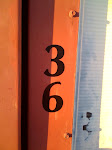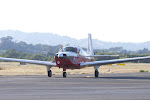Saturday, August 16, 2014
Wednesday, August 4, 2010
Saturday, May 15, 2010
Learn to Fly Day
Today was International Learn to Fly Day. One of the flight schools held an open house so there were a few more folks wandering around than normal. I was out working on our Mooney when I decided to take a little walk with a friend. We discovered a P-51 Mustang at the Pacific Coast Air Museum. This one is called Red Dog XII. It is regularly flown by Chuck Yeager and it's owned by a friend of his. I even found his signature on the tail of Red Dog. But the best part of the day was hearing what I thought was the voice of a friend of mine, Darren Hopkins, who was soloing a Cessna 172. After he landed I went around the hangar and caught him pulling into the flight school. I took his movie camera and filmed his instructor cutting the tail off his shirt. This is a tradition for pilots who solo. It goes back to the days when student pilots sat in front of their instructors. In order to signal the students in the noisy open-cockpit planes, the instructor would tug on the shirttail. After they soloed, the instructor cut off the shirttail as a sign they were good enough to not need those signals any more. For the next few weeks, the back of Darren's shirt will be on display at North Coast Aviation. Three other pilots near my hangar saw the back of Darren's shirt missing and knew what he had just accomplished and congratulated him. And he did it on Learn to Fly Day.
Wednesday, May 12, 2010
Monday, May 10, 2010
An Afternoon At KSTS, Santa Rosa
I am always reminding myself to bring my nice camera pack to the airport every time I visit. I usually forget. So I end up with a lot of poor quality iPhone photos to “prove” what I saw. In our hangar we have a solar powered scanner set-up that lets us in on most everything that happens before it happens. I’ve been witness to three accidents, one dead-stick landing, several amazing military landings, a large number of war bird sightings and VIP arrivals. For such a small class D airport we seem to get plenty of action.
Our Mooney is undergoing an annual so we’re busy taking off panels and other things under the watchful eye of our mechanic. Friday afternoon was another of those days spent at the airport listening to the tower and working on the plane. And, of course, I forgot my camera at home.
The first event was two Apache attack gunships arriving from Camp Pendleton. They made a couple low passes and landed on the ramp. Two officers each readied their ships for an overnight stay and left the airport.
Over the scanner I hear Santa Rosa tower talking to a “Fortress.” A couple minutes later I hear the amazing unmistakable sound of four radial engines and then see a beautiful Boeing B-17 Flying Fortress low in the pattern slowly making its way to the ground. It did a couple of low passes and then made a series of touch-and-go landings. I called my daughter and begged her to bring me my camera.
After about four landing cycles I heard another familiar sound. It was a Rolls Royce attached to Lady Jo, a local P-51 Mustang that lives at our field along with a couple others. As she rolled out of the hanger I knew I was in for a rare treat. There are not many of either of these planes still flying.
The Fortress took off and headed toward the south. Following about 3 minutes behind was Lady Jo. A few minutes later they both flew back and the Fortress made a few landings with Lady Jo doing low fly-bys. I stood at the end of my row of hangars and enjoyed the show along with a few other hanger owners fortunate enough to have field access.
Unfortunately, by the time my daughter showed up with my camera, Lady Jo went back to her hangar. My iPhone photos were horrible so I never got a shot of them together. I did get a few shots with my good camera but the sun was setting so I was shooting into the light making photography rather difficult.
One of my favorite parts of the afternoon was listening to our tower speak to the Fortress and the Mustang together. Several of the landing pilots of a more common name brand (Cessna, Mooney, Piper) commented on what an amazing site it was to see those old birds in the pattern.
For those who knew what they’re looking at it was an amazing afternoon. And for the person who called the tower with a noise complaint, you should not have moved next to the airport if you didn’t want to hear noise. Santa Rosa’s airport was activated in 1942. Your housing development was built only 15 years ago. And those planes you heard overhead helped to win the greatest war this country has ever fought. It won’t be much longer and they will all be so old and tired that they will only be found in museums. And those of us who choose to live near the airport and love the sounds of history will remember the last time we heard one of those old birds overhead. We will struggle to describe it. But we will never forget it.
Monday, March 1, 2010
Mooney M20D Master
We fly a fixed-gear Mooney which is quite the novelty. I thought I would post an advertisement of this plane for folks to look at. Ours is one of three left that are unconverted. It's a 2 MB file so give it a second to load after clicking on it.
Saturday, January 30, 2010
Mid Air Collision
During flight training you’re required to plan and fly a long cross-country adventure. You leave from your home airport and travel in a giant triangle stopping at two other airports at least 100 miles from each other. Back in the 80’s GPS did not exist so I used a combination of navigational aids called a VOR and good old-fashioned dead reckoning. Dead reckoning involves using a map to calculate your route and a slide rule to calculate variables such as time and wind speed. It’s not easy, but that’s the point.
This particular cross-country would be a solo flight. My first stop was uneventful and I even found someone with a stamp to sign my logbook proving I was there. The second leg of my adventure was also uneventful. In fact, it was kind of boring because a large easy-to-see freeway connected the two cities. Following the map and making corrections for the upper level winds were easier because of the freeway.
The last leg of the trip should have also been uneventful. My home airport was within site of two very large towers from a power plant. They could be seen for miles. Once at altitude I would have no problem getting them in my sites making my navigation as easy as following a freeway. But easy flying is also boring flying. Making matters worse is that flying in Southern Minnesota means miles upon miles of fields and small towns.
Back then we never had air traffic flight following. Today, depending on their workload, air traffic controllers will monitor your flight and inform you of traffic nearby. It comes in handy over the busy Northern California skies. But this day I was on my own. Rarely did I ever see any traffic. The skies were usually wide open, but not this day.
I was at 5,500 feet when suddenly a large plane appeared climbing up at me. The sun had reflected off his wings giving him away. I quickly turned to the right and immediately lost track of him. I had been making position reports at airports along the way but did not hear him. It was a very close call. I was a bit shaken but I quickly resumed my course. Just as I reached my previous course it happened again. Did we both make a giant circle only to get in each other’s way, again? Once again I quickly banked to the right. Was it another plane? I had no idea.
I regained my course and altitude when it happened a third time. This time I decided to stay at a higher altitude. I regained my course and in about 5 minutes I flew over a gigantic, very reflective tin-roofed turkey barn. It had been an optical illusion. The sun was at the right angle to send a long reflection straight at me on the horizon.
When I returned I told my instructor that I almost had three mid air collisions. “What kind of planes,” he asked. “Two were Butterballs and one was a Jennie-O,” was my reply. I told him about the turkey barns and I almost got laughed out of the FBO.
Subscribe to:
Comments (Atom)













